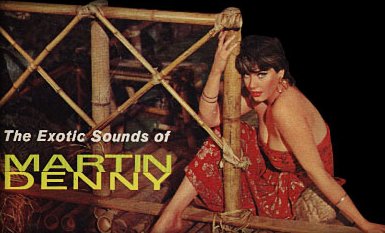

the cabaña
Les BaxterAfter World War Two ended and American servicemen returned home from the Pacific Theater of Operations, many of them missed the bucolic life they observed (if not experienced) on islands such as Hawaii, Truk, Guam and the Marshall Islands. Others had been stationed in southern India, Burma or Africa, and brought back artifacts and memories of the exotic cultures they had experienced. America in the postwar era was an exciting, busy, modern place, but at the end of the day, when work was done, many GIs wished they were back in a grass hut with a dusky native girl serving them drinks out of a coconut shell. This longing for the exotic was not lost on composer/arranger/bandleader Les Baxter in Los Angeles. Baxter was a genius in the recording studio as well as at putting together appealing sounds for live big bands. In 1951, picking up on the wistfulness of the American man for all things exotic, he wrote a song called "Quiet Village". With its vaguely Hawaiian/Latin sound, it was an instant hit and copied by bandleaders worldwide. Knowing a good thing when he saw it, Baxter turned out one exotic piece after another, mining deeper and farther into foreign influences. The trip lasted for nine years and more than a dozen albums. Baxter never stooped to kitsch, and even the most mannered of his works have artistic merit. Two other things set him apart from his contemporaries were that he scored soundtracks to major films, and he was the first composer/arranger to use the theremin on records. He always considered himself a "serious" composer like Stravinsky and, even though his reputation may not reflect it, we can assess his claim more favorably now, after a half-century of hindsight. If nothing else, Baxter is certainly the father of "exotica". "The Exotic Moods of Les Baxter" on Capitol is an excellent collection of his exotic-influenced works. Martin DennyMartin Denny is probably better-known than Les Baxter in the genre of "exotica" for two reasons: he was the bandleader at the world's most famous "tiki" restaurant, and his album covers featured attractive, scantily-clad models in exotic settings. Having said that, Denny's career in exotica was entirely predicated on Baxter's. In 1956, Denny took Baxter's first hit - "Quiet Village" and, instead of performing it with a 60-piece orchestra like Baxter, scaled it down to a 7-piece combo. One of those seven musicians was Augie Colon, a percussionist, who discovered that the audience loved the sound of exotic birdcalls during the songs, and turned that gimmick into an integral part of the band's sound. Denny also discovered many exotic Asian instruments and incorporated them as well. The combo became so popular in their Chicago home that they were hired to become the house band at "Donn the Beachcomber's", the original "tiki bar", in Hawaii. Scamp Records has reissued two of Denny's biggest hits - "Quiet Village" and "The Enchanted Sea" as a double CD, but it is still possible to find the LPs for a few dollars in thrift stores, whose evocative covers can be fully appreciated. Arthur LymanFirst known as one of Martin Denny's main marimba/vibes players, Arthur Lyman soon struck out on his own as a bandleader. The main differences between his sound and that of his former employer is that he usually used a standard 3 or 4 piece jazz combo behind him and played many jazz standards in the exotica style, as well as pure exotica. The other distinctive thing about him was that - unlike Baxter and Denny, he actually was exotic, being a native Hawaiian. Many of his recordings were done in the fabulous aluminum geodesic dome at the Kaiser Center in Hawaii. His 1959 release "Leis of Jazz" is particularly good and readily available on CD from Rykodisc. Yma SumacJust who is Yma Sumac? Rumors abound: was she indeed an Inca princess -- discovered in the Peruvian jungle and brought to America? Or was her true name Amy Camus ("Yma Sumac" spelled backwards) and was she really a housewife from New Jersey? Whatever the truth, she was a singer with an amazing, four-octave voice. Her first record, in 1950, "Voice of the Xtabay" was full-fledged exotica, with mysterious animal cries and primitive chants backing her singing in some unknown tongue. The mystery surrounding her past (and the careful cultivation of her image) propelled her into the limelight and she was soon appearing on stage and in films as well as making popular recordings of more "Incan sounds". Then, in the early '60s, she disappeared without a trace. Although she reappeared in the mid-'70s and sporadically performed thereafter, it was to increasingly indifferent or esoteric audiences. Her work has been reissued on Capitol, and gives a good idea of what the hype was all about: an amazing voice in an exotic setting. Rarely has exotica been so dramatic and, well - goofy. EsquivelJuan Garcia Esquivel (please, just call him "Esquivel") was a self-created legend of latin-influenced lounge. Born in a village in Mexico, he became an in-demand studio pianist at radio stations in Mexico in the late 1940s. Within a few years he was studying music at Julliard in New York, then writing background music for radio in Manhattan. Soon, he was leading his own band and, turning out crowd-pleasing cocktail music. But this was cocktail music with a difference. Esquivel was not just a composer/arranger/conductor, he was also genuinely fascinated with making new sounds. His zeal for unusual instruments led to the use of (among other things) theremins, Hawaiian guitars, and a "boo-bam" -- a set of 24 bongos, tuned to a two-octave scale. He also livened things up with a group of singers whose only purpose was to insert cartoon-like sounds as punctuation at the desired moments ("boink-boink!") and pose rhetorical questions ("Whatchamacallit, Esquivel?"). He also played around with tricky time signatures that made the standard latin rhythms of the day seem quite sedate. Esquivel's music pushed "lounge" into areas it had never been and forced more complacent bandleaders to spice things up a bit. His music is hugely fun and much of it has been re-released on the Bar/None label. Perhaps the best of the collections are "Space-Age Bachelor Pad Music" (which pretty much says it all), "Other Worlds, Other Sounds" and "Infinity in Sound". the space station the lounge the cabaret the jazz club the conservatory the concert hall the trip the screening room |